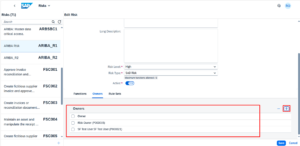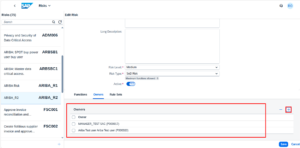In the dynamic landscape of enterprise resource planning, ensuring robust security and compliance is paramount. SAP Identity Access Governance (IAG) offers a comprehensive suite of tools designed to manage and mitigate risks associated with user access and permissions. One significant feature within SAP IAG is the ability to define multiple risk owner paths, an essential function for organizations with intricate governance requirements.
Understanding Risk Ownership
Risk ownership within SAP IAG refers to the assignment of responsibility for the identification, assessment, and mitigation of risks associated with user access and permissions. Typically, a risk owner is a key stakeholder or manager who has the authority and expertise to make informed decisions regarding risk management strategies.
The Need for Multiple Risk Owners
In complex organizational structures, a single risk owner may not suffice to cover all the nuances and intricacies of varied business processes and compliance requirements. Multiple risk owners ensure that risks are managed by the most appropriate individuals, providing specialized oversight and decision-making capabilities. This approach is particularly beneficial in large organizations with diverse departments, each with its own set of unique risks and regulatory demands.
Use Case
- Risk Master Data with multiple Risk owners:
- Risk owner work item for user RO:
- Risk owner work item for user SR:
Benefits of Multiple Risk Owner Paths
Implementing multiple risk owner paths within SAP IAG offers several key advantages:
1. Enhanced Specialization
By distributing risk ownership among experts in different domains, organizations can leverage specialized knowledge and skills to manage risks more effectively. This leads to more accurate risk assessments and targeted mitigation strategies.
2. Improved Compliance
Multiple risk owner paths ensure that all regulatory and compliance requirements are thoroughly addressed by individuals who understand the specific legal and operational contexts. This reduces the likelihood of non-compliance and associated penalties.
3. Increased Accountability
Clear assignment of risk ownership fosters a culture of accountability. Risk owners are held responsible for their respective risks, ensuring that they take proactive measures to identify, assess, and mitigate risks in a timely manner.
4. Streamlined Risk Management
Efficient routing of risks to the appropriate owners minimizes delays and enhances the overall efficiency of the risk management process. This enables organizations to respond swiftly to emerging threats and vulnerabilities.
Challenges and Considerations
While multiple risk owner paths offer numerous benefits, there are also challenges and considerations that organizations must keep in mind.
1. Complexity in Coordination
Managing multiple risk owners requires effective coordination and communication to ensure that all stakeholders are aligned and informed. This can be challenging in large organizations with dispersed teams.
2. Consistency in Risk Assessment
Ensuring consistency in risk assessment across different owners is crucial to maintain a unified risk management approach. Organizations must establish standardized criteria and guidelines for risk evaluation.
3. System Configuration
Proper configuration of risk owner paths within SAP IAG requires careful planning and technical expertise. Organizations may need to invest in training and support to ensure that the system is set up correctly.
Conclusion:
Multiple risk owner paths in SAP IAG provide a robust framework for managing complex risk landscapes within large and diverse organizations. By assigning risk ownership to specialized individuals and establishing clear workflows, organizations can enhance their risk management capabilities, improve compliance, and streamline operations. While challenges exist, the benefits of a well-implemented multiple risk owner strategy far outweigh the potential drawbacks, making it a critical component of effective identity and access governance.







